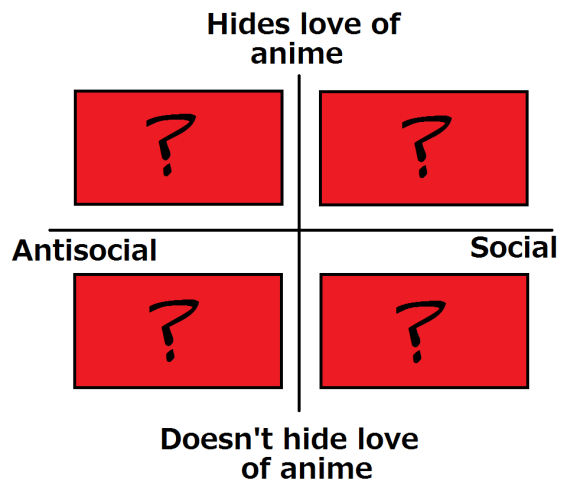
Which otaku quadrant do you fall into?
At some point, Japanese society needed a way to refer to its members who were extremely passionate about anime. Eventually, “otaku” was decided on, and the word has filled its role nicely for the past few decades.
But as popular culture continues to evolve, so too must language. Enthusiastic anime fandom now takes on many forms beyond the loner who isolates himself from the rest of the world as he spends every spare moment quietly consuming anime. That’s why marketing analyst Yohei Harada says it’s more accurate to think of Japanese animation fanatics as one of four classes of modern otaku.
In his new book, Shin Otaku Keizai (“New Otaku Economics”), Harada uses two parameters to divide the groups of new otaku, or “shin otaku” to use the completely Japanese term.
▼ Cover of Shin Otaku Keizai
Let’s take a look at the breakdown.
1. The barely surviving otaku (zanson gachiotaku)
This group represents what Harada considers to be the gradually disappearing, stereotypical otaku: someone whose deep love for anime is a result or cause of social isolation (or perhaps both), and who keeps his intense appreciation of the medium on the down-low. While there are still some people who fit this description, Harada asserts that many members of this demographic are evolving into one of the other three .
2. The hidden otaku (kakure otaku)
While he loves anime, the hidden otaku doesn’t wear his fandom on his sleeve, and keeps his otaku leanings and active social life as separate aspects of his identity.
3. The painful otaku (itaota)
Like the anime character-emblazoned cars called itasha, the itaota designation is derived from the Japanese word itai, or “painful,” implying that they’re somewhat painful to look at. The painful otaku isn’t shy about trumpeting his otaku-ness, but isn’t particularly inclined to participate in social interactions either. The guy or girl who trudges silently around Akihabara every weekend, with their only company the dozens of pins of their favorite anime character that they’ve attached to their bag, seems like someone who would fall into this group.
4. The reality-based otaku (riaju otaku)
Ria ju, literally “real type,” was originally a word coined by otaku in Japan to describe what they saw as their polar opposite: people who spent most of their free time interacting with other people, instead of focusing on the lives and stories of fictional characters. But Harada explains that nowadays, plenty of people are happy to spend time with both their 2-D and real-world friends.
As a matter of fact, Harada says that some of them make a point of being open with their otaku tastes, especially in their online personas. Doing so helps them open up new lines of communication and broaden their social networks, which in turn feeds into their enjoyment of those human-to-human connections.
While the names of these four groups may not have quite the stylish impact of iconic anime organizations like the Shinigami, Sailor Senshi, or Newtypes, Harada’s analysis highlights the changing relationship Japan has with its own works of animation, as well as why “nerd” doesn’t quote cover all the bases as a translation for “otaku.”
Special thanks to Rocketnews24 reader Carrot Glace for the tip!
Source: Confidence/Yahoo! News Japan, Oricon Biz Online
Top image: RocketNews24
Insert images: Amazon Japan, RocketNews24